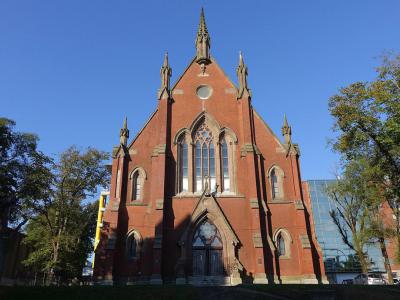
Church of Saint David, Halifax
The Church of Saint David was born in 1925, when the Presbyterians leased and then purchased the former Grafton Street Methodist Church as their congregational home. The building stands atop a hill on Grafton Street, over and in the midst of the Old Methodist Burying Ground of Halifax, which is one of the most sacred sites of Maritime Methodism. Much valued for its historical and spiritual association with Methodism and the creation of the United Church in Canada, the place is also valued for its association with the talented and renowned architect, David Stirling.
Born in Scotland and immigrated to Canada about 1847, Stirling created many a building in Newfoundland, Nova Scotia and Ontario prior to designing the Grafton Street Church, in 1865. The latter was built in 1868-1869 (opened on November 7, 1869) on the site of an earlier, wooden church, erected in 1852 and burned down on February 23, 1868, leaving a small cemetery that still exists.
Designed in the Victorian Gothic (aka Early English or English College Chapel) style, Sterling's creation is a rare, if not unique, example of such architecture, constructed in brick in the province. It is more typical of Stirling's later Gothic-Revival style churches than his earlier ones; Grafton Street is the older of Stirling's two surviving Halifax churches.
The building is highlighted by its great front gable with tall Gothic buttresses and five detailed finials that project above the roof line. Most notably, the church was built without a steeple. Still, its front façade is quite striking and dominates the block.
Initially named simply the Presbyterian Church, the temple was renamed in 1930 in honor of the saintly King David I of Scotland, who reigned from 1124 to 1153.
Born in Scotland and immigrated to Canada about 1847, Stirling created many a building in Newfoundland, Nova Scotia and Ontario prior to designing the Grafton Street Church, in 1865. The latter was built in 1868-1869 (opened on November 7, 1869) on the site of an earlier, wooden church, erected in 1852 and burned down on February 23, 1868, leaving a small cemetery that still exists.
Designed in the Victorian Gothic (aka Early English or English College Chapel) style, Sterling's creation is a rare, if not unique, example of such architecture, constructed in brick in the province. It is more typical of Stirling's later Gothic-Revival style churches than his earlier ones; Grafton Street is the older of Stirling's two surviving Halifax churches.
The building is highlighted by its great front gable with tall Gothic buttresses and five detailed finials that project above the roof line. Most notably, the church was built without a steeple. Still, its front façade is quite striking and dominates the block.
Initially named simply the Presbyterian Church, the temple was renamed in 1930 in honor of the saintly King David I of Scotland, who reigned from 1124 to 1153.
Want to visit this sight? Check out these Self-Guided Walking Tours in Halifax. Alternatively, you can download the mobile app "GPSmyCity: Walks in 1K+ Cities" from Apple App Store or Google Play Store. The app turns your mobile device to a personal tour guide and it works offline, so no data plan is needed when traveling abroad.
Church of Saint David on Map






Sight Name: Church of Saint David
Sight Location: Halifax, Canada (See walking tours in Halifax)
Sight Type: Religious
Guide(s) Containing This Sight:
Sight Location: Halifax, Canada (See walking tours in Halifax)
Sight Type: Religious
Guide(s) Containing This Sight:
Walking Tours in Halifax, Canada
Create Your Own Walk in Halifax
Creating your own self-guided walk in Halifax is easy and fun. Choose the city attractions that you want to see and a walk route map will be created just for you. You can even set your hotel as the start point of the walk.
Halifax Historical Buildings
Between the impressive waterfront and colorful, bustling streets, Halifax is a picturesque city. Much of its fascinating history is duly reflected in the local architecture. There are a number of historical landmarks in Halifax, including the time-honored buildings, palaces, and churches, where you can learn much about its glorious past.
The presence of these historical locations is bound to... view more
Tour Duration: 1 Hour(s)
Travel Distance: 1.6 Km or 1 Miles
The presence of these historical locations is bound to... view more
Tour Duration: 1 Hour(s)
Travel Distance: 1.6 Km or 1 Miles
Halifax Introduction Walking Tour
Halifax is located on the ancestral lands of the Mi'kmaq who lived in the area long before Europeans arrived. Mi'kmaq called the area "Great Harbor". The city itself was established by the British in 1749 in violation of treaties with the Mi'kmaq. The establishment of the city led to Father le Loutre's War, otherwise known as the Anglo-Micmac War.
General Edward... view more
Tour Duration: 2 Hour(s)
Travel Distance: 2.9 Km or 1.8 Miles
General Edward... view more
Tour Duration: 2 Hour(s)
Travel Distance: 2.9 Km or 1.8 Miles


